Mordor was a black, volcanic plain in the southeast of Middle-earth to the east of Gondor, Ithilien, and the great river Anduin. Mordor was chosen by Sauron as his realm because of the mountain ranges surrounding it on three sides, creating a natural fortress against his enemies preventing them from easily invading it.
Geography
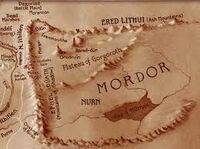
Mordor was protected from three sides by large mountain ranges, arranged roughly in a rectangular manner: the Ered Lithui ('Ash Mountains') in the north, and Ephel Dúath ('Mountains of Shadow') in the west and south. In the northwest corner of Mordor the deep valley of Udûn was one of the few entrances for large armies. Guarding the entrance was the Black Gate of Mordor. In front of the Black Gate lay the Dagorlad or the Battle Plain. Sauron's main fortress of Barad-dûr sat at the end of a spur of the Ered Lithui. To the southwest of Barad-dûr lay the arid Plateau of Gorgoroth and Mount Doom; to the east lay the plain of Lithlad. Mordor's geography was excellent for defense against enemies attacking on all fronts, for nearly un-scalable mountains defended Mordor on three sides, while the broken, jagged land of Gorgoroth and Núrn would greatly impede any army that managed to break through.
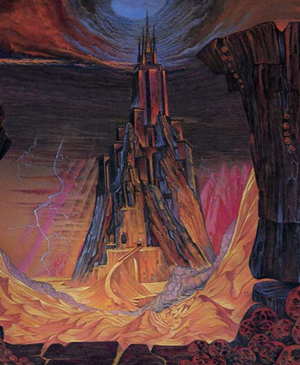
Mordor's dry and blasted geography would also be extremely unfriendly to any army bivouacked on the plains, forcing a withdrawal within days (unless they have stores sufficient for months). The only other paths for armies to cross into Mordor from the west, over the Ephel Dúath were the Morgul Pass and the pass of Cirith Ungol. Isildur originally built the city of Minas Ithil to guard the western end of both passes from any threat from Mordor, but in the Third Age the population of the city waned and it was conquered by the Nazgûl. It became the home of the Ringwraiths and was renamed Minas Morgul, and was thereafter a great stronghold of evil, ever at war with Gondor to the west until the end of the War of the Ring. To escape the vigilance of Morgul, to enter Mordor one would still have to get past the lair of Shelob, and the Tower of Cirith Ungol- a feat only Frodo Baggins and Samwise Gamgee (led by Gollum) ever accomplished - though not without being waylaid by the great fearsome spider Shelob, and Frodo being taken prisoner to the Tower of Cirith Ungol.
The southern part of Mordor, called Núrn, was slightly more fertile, and watered enough to hold the inland Sea of Núrnen. Nurn was made somewhat fertile because the ash blown from Mount Doom left its soil nutrient-rich, thus allowing dry-land farming.
To the west of Mordor was the narrow land of Ithilien with the city of Osgiliath and the great river Anduin, while directly east of it was Rhûn, and to the southeast, Khand.
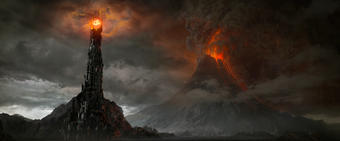
The east of Mordor is by far the least mentioned of any of Mordor's geographic notes and descriptions. One might assume that the easiest route to Mount Doom would be for the Fellowship to journey through the 'unguarded' section in the east, which no mountains obstructed. However, it would have been difficult to pass unnoticed, because the many roads running from Mordor into Rhûn were often marched along by Easterlings entering Mordor or patrolling the roads and borders.
Mountains and passes
- Ephel Dúath
- Ered Lithui
- Morgai
- Mount Doom (Orodruin, where Frodo cast the Ring and destroyed it)
- Cirith Ungol
- Morgul Pass
- Cirith Gorgor
Regions
- Plateau of Gorgoroth
- Udûn
- Lithlad
- Núrn (surrounding the Sea of Núrnen)
- Morgul Vale (source of the Morgulduin river)
Named Orc-holds
- Barad-dûr (Capital and seat of the Dark Lord Sauron)
- Durthang
- Isenmouthe
- Minas Morgul (home of the Nazgûl, including the Witch-king)
- Black Gate
- Towers of the Teeth
- Tower of Cirith Ungol
History

Early history
Mount Doom was created by Morgoth during the First Age.[2] In unknown moment of First Age, perhaps shortly around the War of Wrath, Shelob left the Nan Dungortheb and settled there with her offspring. Sauron settled in Mordor 1,000 years after the end of the First Age, and it remained the centre of his power for the whole of the Second Age and again at the end of the Third Age of Middle-earth. In the north-western corner of this land stood Mount Doom, where Sauron had forged the One Ring. Near Mount Doom stood Sauron's stronghold Barad-dûr. After this time, Sauron was known as the Dark Lord of Mordor.
For two and a half thousand years, Sauron ruled Mordor uninterruptedly. Having wrought the Ring, it was from there that he launched the attack upon the Elves of Eregion in the War of the Elves and Sauron. He was repelled by the Men of Númenor. He later opposed Númenor, but such was their power that his own servants deserted him and he was captured by the Númenóreans and brought to their island kingdom, eventually causing its destruction (see the Downfall of Númenor). Immediately after Númenor's destruction, Sauron returned to Mordor as a spirit and resumed his rule.
The Last Alliance and Third Age

Sauron's rule was interrupted again when his efforts to destroy Gondor failed; his forces were driven back and the Last Alliance of Elves and Men formed to oppose him. After the Battle of Dagorlad the army of the Last Alliance entered Mordor and besieged the Barad-dûr for seven years. Eventually Sauron came forth and was defeated in a final battle on the slopes of Mount Doom. For about 1600 years, Mordor was guarded by Gondor in order to prevent evil from returning. The Towers of the Teeth, Durthang and the Tower of Cirith Ungol were built by Gondor to watch the major entry points to the dark land. Gorgoroth during this time was desolate, with the Barad-dûr levelled down to its foundations.
However following the Great Plague in TA 1636 the watch on Mordor failed and evil began to creep back in. Sauron eventually used the Wainriders to distract and weaken Gondor, and the Nazgûl re-entered in TA 1980. They reclaimed Mordor and started to rebuild its might. Minas Ithil was conquered by the Nine Ringwraiths in TA 2002 and Gondor's abandoned fortresses were occupied by evil creatures. By the time Sauron returned to Mordor in TA 2942 after his false defeat at Dol Guldur (in the events that took place at the time of Bilbo Baggins's quest), Mordor was too strong to be captured by any military might that was available in Middle-earth at the end of the Third Age. Sauron declared himself openly in TA 2951 and Mount Doom burst into flame three years later.
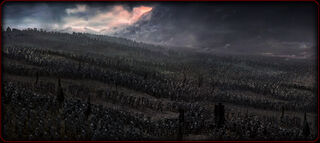
War of the Ring
In the War of the Ring, Sauron gathered all his forces to Mordor. In the north were great garrisons and forges of war, while surrounding the bitter inland Sea of Núrnen to the south lay the vast fields of Núrn tended for the provision of the armies by hordes of slaves brought in from lands to the east and south. After the Battle of the Pelennor Fields, the Army of the West marched to the Black Gate. Sauron sent his army to destroy the Men of Gondor and Rohan at the Battle of the Black Gate, but then Frodo Baggins destroyed the One Ring and Mordor fell. Sauron's power was destroyed, sending shock waves through the air and ground. The Dark Tower of Barad-dûr, the Black Gate and the Towers of Teeth collapsed into ruin. Mount Doom erupted and both Sauron and his Ringwraiths were destroyed. The shadows dissipated and Aragorn II gave the land to Sauron's slaves. It is untold what became of the remaining Orc-holds.
Formation
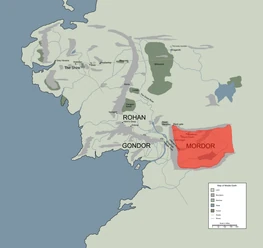
In The Atlas of Middle-earth, Karen Wynn Fonstad assumes that the lands of Mordor and Khand lay where the inland Sea of Helcar had been, and that the Sea of Rhûn and Sea of Núrnen were its remnants. In particular, she suggested that the uplift of the Plateau of Gorgoroth was closely related to the formation of Mount Doom and that the Ephel Dúath formed as a result of a tectonic uplift caused by the cataclysms of the War of Wrath.[3][4] However, The Peoples of Middle-earth, the 12th volume of The History of Middle-earth, which was published after the Atlas, states that at least Mount Doom was created by Morgoth during the First Age, so before the draining of the Sea of Helcar. Also the name Mordor was given already before Sauron settled there.[5]
Languages and people
At the time of the War of the Ring, Sauron had gathered great armies to serve him. These included enslaved Men of the East and the South, who spoke a variety of tongues, and Orcs and Trolls, who usually spoke a debased form of the Common Speech. But within Barad-dûr and among the captains of Mordor (the Ringwraiths and other high-ranking servants such as the Mouth of Sauron), the Black Speech was still used, the language devised by Sauron during the Dark Years of the Second Age. In addition to ordinary Orcs and Trolls, Sauron had bred a stronger strain of Orcs, the Black Uruks, and very large Trolls known as Olog-hai who could endure the sun. The Olog-hai knew only the Black Speech.
Etymology
Mordor has two meanings: The Black Land or The Dark Land in Tolkien's contrived language Sindarin, and The Land of Shadow in Quenya. The root mor ("dark", "black") also appears in Moria. Dor ("land") also appears in Gondor ("stone-land") and Doriath ("fenced land"). The Quenya word for Shadow is "mordo". It is pronounced with a Russian-sounding r. The gate of Mordor, Morannon, means Black Gate. It was named this by the Elves in the Second Age.
A proposed etymology out of the context of Middle-earth is Old English morthor, which means "mortal sin" or "murder". (The latter are descended from the former.) It is not uncommon for names in Tolkien's fiction to have relevant meanings in several languages, both those invented by Tolkien, and "real" ones, but this of course happens with any two languages. Mordor is also a name cited in some Nordic mythologies referring to a land where its citizens practice evil without knowing it, imposed on themselves by the society long created for that purpose. This quite fits with Tolkien's Mordor.
In adaptations
In Middle Earth: Shadow of Mordor
In Monolith's Middle-earth: Shadow of Mordor, set sometime between the Hobbit and Fellowship of the Ring, the player character Talion is a member of Gondorian Rangers that garrison the Black Gate. The position is treated as being close to exile, as Talion had been stationed there for killing a nobleman in defense of his wife. The Rangers however are only a token force who watch over the vassal Outcasts, the descendants of Gondorian criminals and freed slaves, the populate Udun. This leads to them being easily and swiftly defeated by a force of Orcs lead by Saurons Black Hand. However, Talion and his family are ritually sacrificed in an attempt to bring back the wraith of Celebrimbor, the Elf that had forged the Rings of Power. Though seemingly a failure for the Black Hand, Celebrimbor and Talion were bound together in undeath, and waged a guerilla war against the Orcish armies, and joining with other resistance factions.
These would include Gollum, currently searching for the One Ring in the region of its creation, and the free Outcasts that had escaped enslavement by the Orcs, led by a Ranger deserter Hirgon. Talion would also travel to Nurn at Thaurband, working with the Queen of Nurn who was under the spell of Saruman but from which she would be freed. Talion would also face the Tower of Sauron at Ered Glamhoth on the other side of the Sea of Nurnen.
Orcish culture is also largely expanded on in this game, showing the web of hierarchy, infighting, and betrayal, as well as the Orc's love for Grog. Mordor's wildlife is also shown off with the feline counterpart of Warg's, the Caragor, the gigantic Graug's, and the underground dwelling Ghul's.
A DLC campaign also showcases Celebrimbor's first war against Sauron. After Sauron's deception as the Giftbringer had been revealed, Celebrimbor took his Elven armies of Eregion against Sauron, but despite a near-defeat the One-Ring slipped from Sauron's hand onto Celebrimbor's allowing him to entirely turn the tide against Sauron. The campaign follows Celebrimbor as he uses the One Ring to dominate Orcs into his army to oppose Sauron. But at the cusp of Celebrimbor's victory the One Ring once again changes sides falling back onto Sauron's hands, allowing him to defeat Celebrimbor where he is then tortured and killed alongside his family that Celebrimbor had assumed long dead.
In Middle Earth: Shadow of War
In Monolith's Middle-earth: Shadow of War, following the events of the previous game Talion and Celebrimbor had decided to forge a New Ring of Power to defeat Sauron's armies, with the ultimate fate of the Udun Outcasts and the Nurn tribesman left unknown. However soon after the New Ring's completion, it falls into the clutches of Shelob (here portrayed as a shapeshifter with prophetic powers).
Talion is soon redirected to Minis Ithil, currently under siege by Saurons armies and led by the Wring-Wraiths, and he encounters the cut-off armies of Gondor defending it. Celebrimbor is chiefly concerned with the recovery of the New Ring, and keeping the Palantir in Minas Ithil out of Saurons hands. Ultimately the siege of Minis Ithil ends when the leader of the Gondorian garrison, Castamir, hands the city over to the Witch-King in exchange for his daughters life, a bargain the ring-wraith's renege on, but his daughter Idril and the soldier Baranor manage to escape to lead a Gondorian resistance in Mordor. With Minas Ithil's fall it is transformed into Minas Morgul.
Here Shelob relinquishes the New Ring to Talion and Celebrimbor, and they begin to liberate Mordor, christening themselves as the Bright Lord and dominating orcs to form their new army. The scope of Mordor is expanded to include a new section of Nurnen, the caves of Cirith Ungol, Minas Ithil/Morgul, the lava-filled crags of Gorgoroth, the ice-covered mountains in Seregost, and a DLC location the arid desert of Lithlad.
Several missions are available in Mordor, including hunting down scattered Gondorian artifacts once held in Minis Ithil, finding memories of Shelob that detail an ancient alliance between her and Sauron, aiding the Forest Spirit of Carnan in defeating an armored Balrog summoned by Saurons army, and returning from the previous game seeing glimpses of Celebrimbor's prior conquest of Mordor with the One Ring, as well as unlocking his ancient set of weapons. Gollum appears once again portrayed as serving Shelob, and a new faction is introduced the Blades of Galadriel who repeatedly hunt down the Ring-Wraith's even as they come back in un-death. The central missions concern assaulting the major forts held by Sauron's armies with various means, and once the Bright Lord has cemented his control of Mordor, assaulting and overthrowing Sauron.
However the final assault of Barad-Dur is waylaid when Talion defeats a Ringwraith and it is revealed to be Isildur. Celebrimbor urges that Talion dominate the former Gondorian King to add them to their ranks, but Talion as a Gondorian refuses. This proves to be the breaking point in their alliance, and Celebrimbor takes the New Ring and gifts it to Eltariel the Blade of Galadriel who sides with Celebrimbor with the promise of finally ending Sauron's rule. This leaves Talion without his earthly tether and he soon begins to die, but he takes Isildur's ring of power to preserve himself, while at the same time opening himself up to Sauron's influence.
Celebrimbor and Eltariel continue the assault on Barad-Dur, confronting Sauron, but Sauron manages to cut the New Ring from Eltariels hand, and the spirits of Sauron and Celebrimbor are then locked into a decades long struggle atop Barad-Dur.
Talion meanwhile, now exiled from the Bright Lord's army establishes his own base in Minas Ithil, and sets to reconquer Mordor from Celebrimbor's army, while at the same time attempting to resist his Ring of Power's corruption. While he eventually succeeds in conquering Mordor, by the end he is finally corrupted as a Ring-Wraith, but these decades long 'Shadow Wars' have stalled Sauron's conquests and ambitions to let the Free People of Middle Earth to rally against Mordor, with Talion finally being banished from undeath when the One Ring is destroyed in Mount Doom.
The culture of Orcs is once again expanded upon, including the addition of the half-troll Olog-Hai. The Orcs are split into several tribe's. The Mystic tribe uses black magic and necromancy, the Dark tribe focuses on stealth and ambush, the Feral tribe has mastered hunting and the domestication of Mordor's fiercest animals, the Maurader Tribe live for plunder and loot, the Machine tribe have mastered Mordor's burgeoning industry, the Warmonger tribe revere warfare itself, the Terror tribe are obsessed with both causing and recieving pain, and with the DLC there are also the Slaughter tribe that butcher their enemies and consume the meat, and the Outlaw tribe that pursue a policy of Mordor for the Orcs, shunning both the Dark and Bright Lords.
DLC campaigns also follow the characters of Eltariel and Baranor following the conclusion of the main campaign.
The Lord of the Rings: The Rings of Power
In Amazon Studios' series The Rings of Power, Mordor and some of the areas around it in southern Rhovanion had been called the Southlands before the making of the Rings of Power and the One Ring. The geographic bounds of the Southlands are not yet specified, but are implied to encompass at least some of Mordor. The characters Adar, Arondir, Bronwyn, Theo, Rowan, Tredwill, Waldreg, and Halbrand are among the lands' inhabitants.
Season One
The villages of Tirharad and Hordern, and the supposed original home of Halbrand, are in the Southlands. The Elf Arondir and his company are first seen stationed in Tirharad.
In episode three, "Adar", Galadriel discovers at Númenor's Hall of Lore that the sigil of Sauron she had seen in various places was, apparently, a small, abstract map of the Southlands, suggesting to her that Sauron had chosen that land to re-establish his presence, in some capacity. The Trenches, the Orc-hold to which Arondir, Revion, and Médhor are taken, is also in the Southlands, likely west of the Ephel Duath. Magrot, an Orc taskmaster, and Adar himself reside there.
In the end of episode six ("Udûn"), Waldreg uses the Orc Sigil Hilt as a key to open a dam. The water flows through tunnels dug by the orcs shown in the prior episodes towards an inactive volcano. When the water hits the underground lavapit, it causes the volcano to erupt, turning the Southlands into an ashen wasteland. It turns out, the volcano is Mount Doom and the desolated Southlands are now renamed Mordor.
Season Two
In episode one, "Elven Kings Under the Sky", Adar is shown in a flashback "killing" Sauron which begins his rise to leadership of the orcs. He continues to consolidate his power in Mordor and meets Halbrand who he tortures into swearing allegiance to the "Lord of Mordor". In episode four ("Eldest"), he appears to have lead his orc legions out of Mordor toward Eregion which he has heard is where Sauron has appeared.
Translations
| Foreign Language | Translated name |
| Amharic | ሞርዶር |
| Arabic | موردور |
| Armenian | Մորդոր |
| Belarusian Cyrillic | Мордор |
| Bengali | মর্ডোর |
| Bulgarian Cyrillic | Мордор |
| Burmese | မေမော်ဒေါ |
| Catalan | Mórdor |
| Chinese (Hong Kong) | 魔多 |
| Danish | Mordor ("Det Mørke Land") |
| Georgian | მორდორი |
| Greek | Μόρντορ |
| Gujarati | મોર્દોર |
| Hebrew | מורדור |
| Hindi | मोर्दोर |
| Japanese | モルドール |
| Kannada | ಮೊರ್ಡೊರ್ |
| Kazakh | Мордор (Cyrillic) Mordor (Latin) |
| Korean | 모르도르 |
| Kyrgyz Cyrillic | Мордор |
| Laotian | ມໂຣດໂຣ |
| Macedonian Cyrillic | Мордор |
| Marathi | मोर्दोर |
| Mongolian Cyrillic | Мордор |
| Nepalese | मोर्दोर |
| New Balaybalan | Alem-eb Quzrak |
| Pashto | موردور ? |
| Persian | موردور |
| Punjabi | ਮੋਰ੍ਦੋਰ |
| Russian | Мордор |
| Sanskrit | मोर्दोर् |
| Serbian | Мордор (Cyrillic) Mordor (Latin) |
| Sinhalese | මොර්දොර් |
| Slovene | Mordor |
| Tajik Cyrillic | Мордор |
| Tamil | மொர்தொர் |
| Telugu | మొర్దొర |
| Thai | มอร์ดอร์ |
| Ukrainian Cyrillic | Мордор |
| Urdu | مورداور |
| Uzbek | Мордор (Cyrillic) Mordor (Latin) |
| Yiddish | מאָרדאָר |
|
Middle-earth Locations:
Provinces/Regions: Arnor | Dunland | Ettenmoors | Forochel | Forodwaith | Gondor | Harad | Ithilien | Khand | Lindon | Minhiriath | Mordor | Rhovanion | Rhûn | Rivendell | Rohan | The Shire Forests & Mountains: Amon Dîn | Amon Hen | Amon Lhaw | Caradhras | Emyn Muil | Erebor | Fangorn Forest | High Pass | Iron Hills | Lórien | Mirkwood | Mount Doom | Mount Gundabad | Old Forest | Orod-na-Thôn | Tower Hills | Weathertop Hill City/Fortifications: Angband | Barad-dûr | Bree | Caras Galadhon | Dol Guldur | Fornost Erain | Hornburg | Isengard | Khazad-dûm (Moria) | Minas Morgul | Minas Tirith | Last Homely House | Tower of Amon Sûl | Tower of Orthanc | Osgiliath | Umbar | Utumno Miscellaneous: Argonath | Astulat | Buckland | Cair Andros | Dagorlad | Dead Marshes | Enedwaith | Fords of Isen | Gap of Rohan | Grey Havens The rest of Arda:
Aman | Burnt Land of the Sun | Dark Land | Empty Lands | Neldoreth | New lands | Númenor | Tol Eressëa |
| Realms of the Dark Lords | |
|---|---|
| Years of the Trees | Utumno |
| First Age | Dor-na-Daerachas |
| Second Age | Mount Gundabad • Mordor |
| Third Age | Witch-realm of Angmar • Mordor |
| Fortresses | |
| Beleriand | Angband • Tol-in-Gaurhoth |
| Middle-earth | Barad-dûr • Black Gate • Carn Dûm • Dol Guldur • Durthang • Minas Morgul • Tower of Cirith Ungol • Towers of the Teeth |
References
- ↑ The Lord of the Rings, Appendix B: The Tale of Years (Chronology of the Westlands), "The Second Age"
- ↑ The History of Middle-earth, vol: 12: The Peoples of Middle-earth, XIII: "Last Writings", pg. 390 (note 14)
- ↑ The Atlas of Middle-earth, The Second Age, "Introduction"
- ↑ The Atlas of Middle-earth, Regional Maps, "Mordor (and Adjacent Lands)"
- ↑ The History of Middle-earth, Vol. 12 The Peoples of Middle-earth, ch. XIII Last Writings